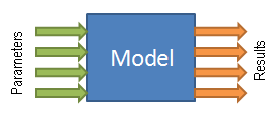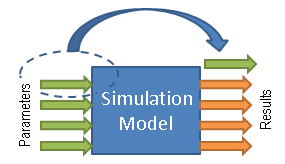Simulations can also be done using a spreadsheet program. Often using a spreadsheet is the first contact with simulation persons needing to play with data for decision making have. This precedence of use marks the way they further approach some industrial simulation issues – not always in a legitimate way, even if the purpose of spreadsheets is of course not questioned.
Whether the model is built with a spreadsheet or using a dynamic simulation program, the aim is often similar. The user wants to get resulting indicators from a set of parameters, so as to more wisely take a decision.

With a spreadsheet program like MS Excel, the modelling technique, and thus the model, are of course quite different from what is constructed with a discrete events simulator ExtendSim, since the simulation tool takes more naturally into account the system’s dynamics. We could think that, for a same set of parameters, the dynamic simulation model provides different results (considered more accurate) than those given by the static calculations in Excel.
In some aspects the difference between the two approaches is deeper. What could be only a parameter in the Excel model may become a result in the dynamic model!

It is specifically the case for the utilization rate of production equipment. Most of the time, in a static model, the utilization rate of a piece of equipment is considered as a parameter. It is specified, for example, that such machine has a utilization rate of 80%. The production capacity of the machine results from the multiplication of this rate by some opening time and by the instant speed of the machine, typically parts per minutes.
The 20% of production capacity "taken" from the model include failures, maintenance, sometimes product changeovers, situations of saturated downstream stock, lack of material etc.
For anyone knowing only static simulation with a spreadsheet, the utilization rate obviously is the major parameter of any dimensioning model. In the real plant itself everything will be done to improve this rate (using techniques like SMED, TPM, 5S, Kaizen, 6Sigma etc.), but in the untouchable Excel model, it is indeed a parameter.
With dynamic simulation it is different: each failure is simulated at the exact time a random distributions sets it, maintenance takes place according to a planning, and above all, situations when the machine is blocked downstream or starved upstream result from contextual conditions with other parts of the model operating. Thus the simulation program can only note for each piece of equipment its utilization rate, which is by definition a result, not a parameter.
Switching from a static perspective to a dynamic perspective, it is important to question every parameter of a model: genuine parameter, or approximated result used as a parameter?